How to group and sum in mysql
In mysql, you can use the SELECT statement with the SUM() function and "GROUP BY" to perform group sums. The syntax is "SELECT query field SUM (summation field) AS field FROM table name WHERE condition GROUP BY Grouping field one, grouping field two;".

The operating environment of this tutorial: windows10 system, mysql8.0.22 version, Dell G3 computer.
How to perform group sum in mysql
In mysql, you can use
SELECT 查询字段 SUM(求和字段) AS 字段 FROM 表名 WHERE 条件 GROUP BY 分组字段一,分组字段二;
to perform group sum.
Examples are as follows:
1) count() finds the number of rows in a certain column
It is easy to understand, count(column name) is to find the number of rows in a certain column The number of rows in the column. It is worth noting that this column does not count the number of rows with null values. Example:
>-- Query how many teachers there are
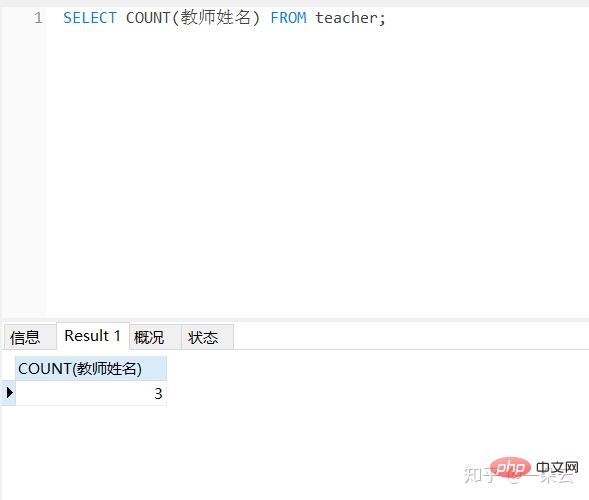
>-- Query how many rows there are in the teacher table SELECT COUNT(*) FROM teacher;
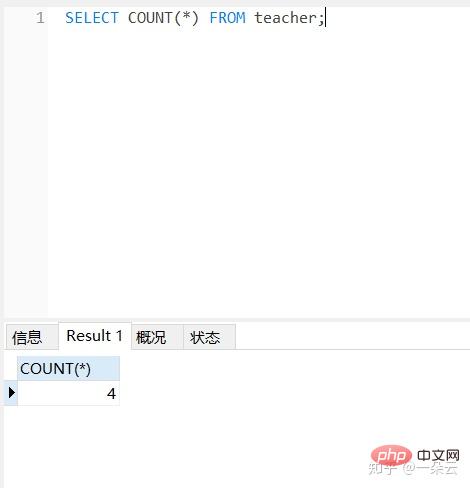
If there are duplicate values in the column, we count and don’t want to count duplicate values, what should we do? We can use distinct to solve:
-- 查询成绩表里共有几个学生的成绩 SELECT COUNT(DISTINCT 学号) FROM score;
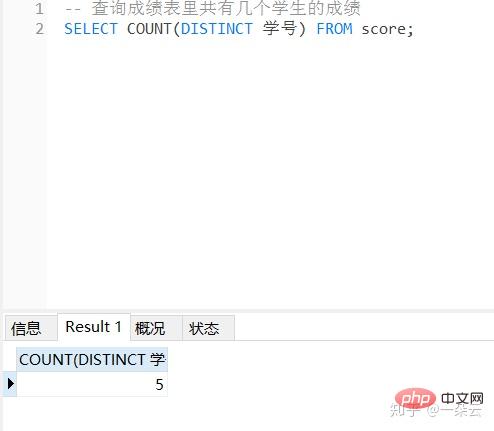
2) sum() sums a certain column of data
sum, that is To sum the values in a column, only numerical values can be calculated. Example:
-- 对所有成绩求和 SELECT SUM(成绩) FROM score;
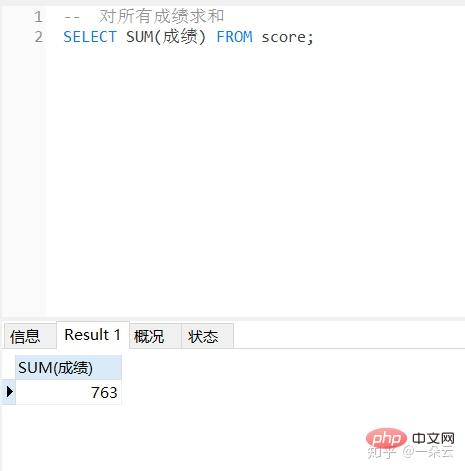
3) avg() averages the values in a certain column
Similarly, the average can only be calculated Calculate numerical values:
-- 对所有成绩求平均值 SELECT AVG(成绩) FROM score;
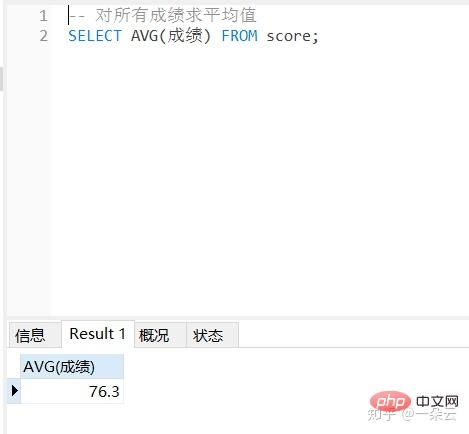
##4) max() finds the maximum value of a certain column of data, min() finds the minimum value of a certain column of data
-- 获取所有成绩中的最大成绩 SELECT MAX(成绩),MIN(成绩) FROM score;

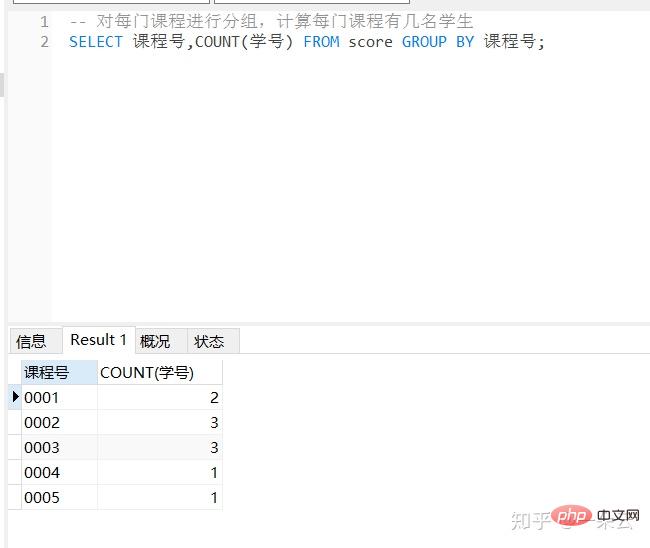
-- 计算每一科课程的平均成绩 SELECT 课程号,AVG(成绩) FROM score GROUP BY 课程号;
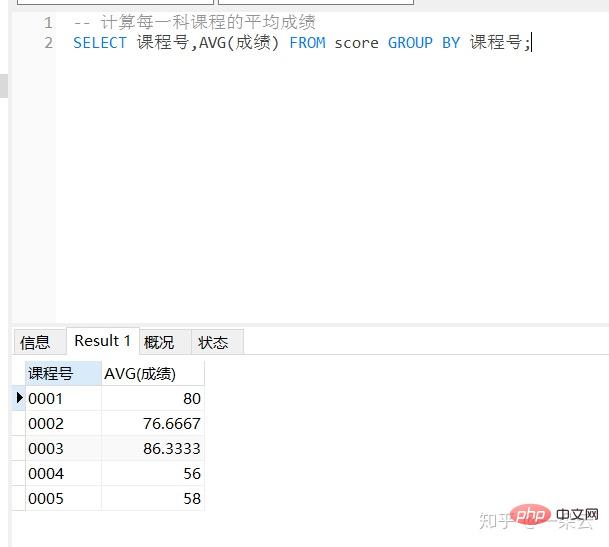
score table and use the group by statement to group the data according to certain rules; then in the group Calculate count() on the results; finally select the combined results and summarize each set of calculation results in the previous step into a table.
Specify conditions for grouping conditionsIn the first question, it is required to "calculate the average score of each subject and get the average score to be greater than or equal to 80 points". In the above two sections, we got the calculation The average score of a subject every day, now specify the condition for the average score: "greater than or equal to 80 points" , we use the having clause.
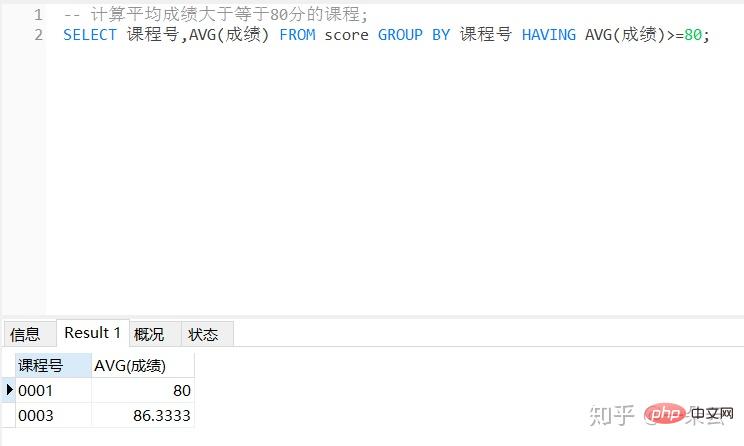
The having clause and the where clause are both conditional selection of data. The difference is that where cannot be used with the summary function.
-- 计算平均成绩大于等于80分的课程; SELECT 课程号,AVG(成绩) FROM score GROUP BY 课程号 HAVING AVG(成绩)>=80;
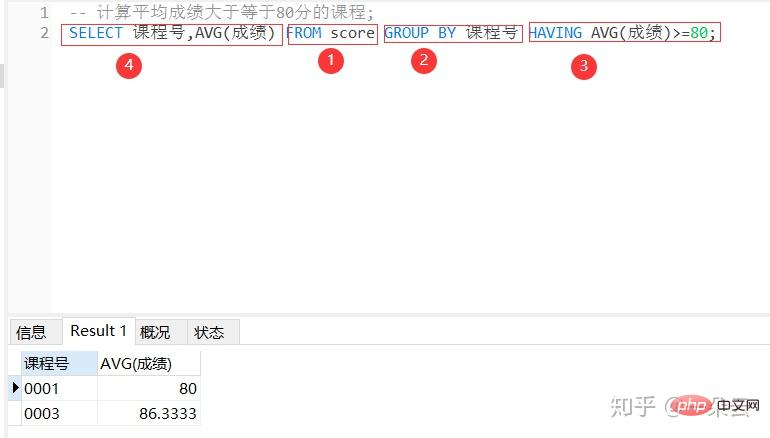
-- 对教师表根据教师姓名排序 SELECT * FROM teacher ORDER BY 教师姓名;
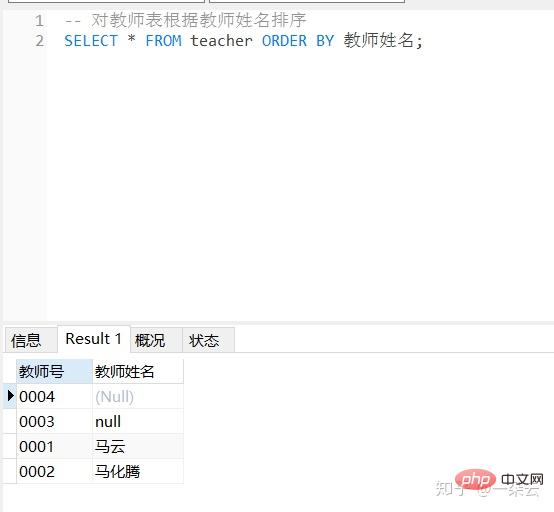
Columns containing null values are sorted when sorting , the null value will be at the beginning, When the amount of data is large and you want to see the null value, you can use this sorting.
另外,在补充一个limit语句,从查询结果中取出指定行,比如,我们如果从刚才的查询结果中只取第一行:
-- 计算平均成绩大于等于80分的课程并根据成绩降序排,并获取第一行 SELECT 课程号,AVG(成绩) FROM score GROUP BY 课程号 HAVING AVG(成绩)>=80 ORDER BY AVG(成绩) DESC LIMIT 1;
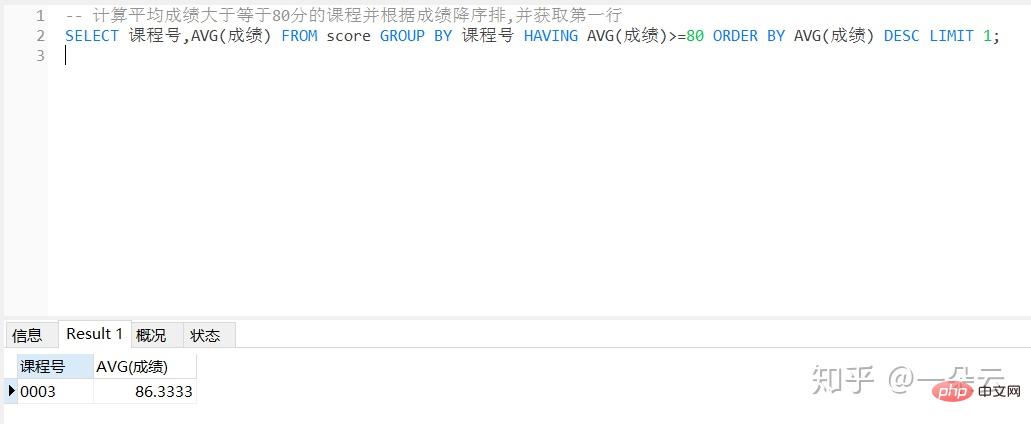
接下来我们进行一个总结。
用SQL解决业务问题分析思路
简单来说:明确问题,将问题翻译成大白话,逐步进行拆解,并写出分析思路和对应的SQL思路。
1) 明确问题,将问题翻译成大白话:
“计算各科的平均成绩并且得出平均成绩大于等于80分的课程并降序排列”翻译成大白话就是:
“计算每一门课程的平均成绩,然后根据得出的结果,进行大于等于80分的条件查询,对查询结果进行降序排列”。
2) 逐步进行拆解,并写出分析思路和对应的SQL思路:
① 对课程号进行分组,计算每一门课程的平均成绩;
② 对①的结果指定条件“>=80”;
③ 对②的结果进行降序排列;
我们可以把拆解后的思路套用到下方的公式中:
select 查询结果 from 从那张表中查找数据 where 查询条件(运算符、模糊查询) group by 分组(每个) having 对分组结果指定条件 order by 对查询结果排序 limit 从查询结果中取出指定行;
试一下吧:
select 查询结果[课程号,avg(成绩)] from 从那张表中查找数据[成绩表score] where 查询条件(运算符、模糊查询)[No] group by 分组(每个)[课程号] having 对分组结果指定条件[avg(成绩)>=80] order by 对查询结果排序[avg(成绩)desc] limit 从查询结果中取出指定行;[No]
这样子,问题是不是就迎刃而解呢?
推荐学习:mysql视频教程
The above is the detailed content of How to group and sum in mysql. For more information, please follow other related articles on the PHP Chinese website!

Hot AI Tools

Undresser.AI Undress
AI-powered app for creating realistic nude photos

AI Clothes Remover
Online AI tool for removing clothes from photos.

Undress AI Tool
Undress images for free

Clothoff.io
AI clothes remover

Video Face Swap
Swap faces in any video effortlessly with our completely free AI face swap tool!

Hot Article

Hot Tools

Notepad++7.3.1
Easy-to-use and free code editor

SublimeText3 Chinese version
Chinese version, very easy to use

Zend Studio 13.0.1
Powerful PHP integrated development environment

Dreamweaver CS6
Visual web development tools

SublimeText3 Mac version
God-level code editing software (SublimeText3)

Hot Topics
 MySQL's Role: Databases in Web Applications
Apr 17, 2025 am 12:23 AM
MySQL's Role: Databases in Web Applications
Apr 17, 2025 am 12:23 AM
The main role of MySQL in web applications is to store and manage data. 1.MySQL efficiently processes user information, product catalogs, transaction records and other data. 2. Through SQL query, developers can extract information from the database to generate dynamic content. 3.MySQL works based on the client-server model to ensure acceptable query speed.
 How to start mysql by docker
Apr 15, 2025 pm 12:09 PM
How to start mysql by docker
Apr 15, 2025 pm 12:09 PM
The process of starting MySQL in Docker consists of the following steps: Pull the MySQL image to create and start the container, set the root user password, and map the port verification connection Create the database and the user grants all permissions to the database
 Laravel Introduction Example
Apr 18, 2025 pm 12:45 PM
Laravel Introduction Example
Apr 18, 2025 pm 12:45 PM
Laravel is a PHP framework for easy building of web applications. It provides a range of powerful features including: Installation: Install the Laravel CLI globally with Composer and create applications in the project directory. Routing: Define the relationship between the URL and the handler in routes/web.php. View: Create a view in resources/views to render the application's interface. Database Integration: Provides out-of-the-box integration with databases such as MySQL and uses migration to create and modify tables. Model and Controller: The model represents the database entity and the controller processes HTTP requests.
 Solve database connection problem: a practical case of using minii/db library
Apr 18, 2025 am 07:09 AM
Solve database connection problem: a practical case of using minii/db library
Apr 18, 2025 am 07:09 AM
I encountered a tricky problem when developing a small application: the need to quickly integrate a lightweight database operation library. After trying multiple libraries, I found that they either have too much functionality or are not very compatible. Eventually, I found minii/db, a simplified version based on Yii2 that solved my problem perfectly.
 How to install mysql in centos7
Apr 14, 2025 pm 08:30 PM
How to install mysql in centos7
Apr 14, 2025 pm 08:30 PM
The key to installing MySQL elegantly is to add the official MySQL repository. The specific steps are as follows: Download the MySQL official GPG key to prevent phishing attacks. Add MySQL repository file: rpm -Uvh https://dev.mysql.com/get/mysql80-community-release-el7-3.noarch.rpm Update yum repository cache: yum update installation MySQL: yum install mysql-server startup MySQL service: systemctl start mysqld set up booting
 Centos install mysql
Apr 14, 2025 pm 08:09 PM
Centos install mysql
Apr 14, 2025 pm 08:09 PM
Installing MySQL on CentOS involves the following steps: Adding the appropriate MySQL yum source. Execute the yum install mysql-server command to install the MySQL server. Use the mysql_secure_installation command to make security settings, such as setting the root user password. Customize the MySQL configuration file as needed. Tune MySQL parameters and optimize databases for performance.
 Laravel framework installation method
Apr 18, 2025 pm 12:54 PM
Laravel framework installation method
Apr 18, 2025 pm 12:54 PM
Article summary: This article provides detailed step-by-step instructions to guide readers on how to easily install the Laravel framework. Laravel is a powerful PHP framework that speeds up the development process of web applications. This tutorial covers the installation process from system requirements to configuring databases and setting up routing. By following these steps, readers can quickly and efficiently lay a solid foundation for their Laravel project.
 MySQL vs. Other Databases: Comparing the Options
Apr 15, 2025 am 12:08 AM
MySQL vs. Other Databases: Comparing the Options
Apr 15, 2025 am 12:08 AM
MySQL is suitable for web applications and content management systems and is popular for its open source, high performance and ease of use. 1) Compared with PostgreSQL, MySQL performs better in simple queries and high concurrent read operations. 2) Compared with Oracle, MySQL is more popular among small and medium-sized enterprises because of its open source and low cost. 3) Compared with Microsoft SQL Server, MySQL is more suitable for cross-platform applications. 4) Unlike MongoDB, MySQL is more suitable for structured data and transaction processing.






